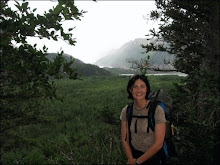
Its day three at McMurdo Field Station. I spent the first two days at Happy Camper, a 2 day long training session that occurs on the fast ice near McMurdo. This training is required for anyone spending any time at remote field camps in Antarctica. Basically we were driven out onto the ice and dropped off for 36 hours to build our own camp, set up tents, cook, and keep warm. There were 20 of us, mostly new to the ice, as veterans just take a short refresher course.

First we went over the basics in the classroom at McMurdo: How to avoid hypothermia, frostbite, sunburn, trenchfoot, etc. Then we picked up our lunches and hopped into 'Delta Trucks', which took us to the Happy Camper site. At this point we got issued 'sleep kits' containing two sleeping pads, a heavy sleeping bag, and a fleece liner. This is more or less what I'll be sleeping on for the rest of the season, with the added bonus of a thermarest, Yay! At this point we hiked out to an untouched area of the ice, and began to set up camp.

First we set up Scott tents. These are canvas tents that were invented at about the same time Captain Scott was trudging his way around Antarctica (1901-1912). They are simple, and can handle winds up to 100 miles per hour if anchored properly.


Next was the Quinzhee Hut. This is constructed by making a massive pile of snow and then digging out the inside. We cheated by piling snow on top of all our gear. Next you dig an entrance into the hut that approaches the interior from underneath. This way all the warm air gets trapped inside. It took 20 people several hours to make one hut, and in the end it only held three people. But I'm told they slept quite warmly.
We also set up 6 Mountain Tents, which are a little more intense than your standard backpacking tent. They hold 2 people and use the usual titanium and bungee pole system. They can't handle nearly the wind the Scott tents do, but their small size makes for warmer sleeping. To insure they did not blow away, we quarried large snow blocks from the pristine snow nearby and built a 50 ft long wall to shelter all the mountain tents. We used shovels and saws to get out the blocks, and stacked them like bricks to create a 4 foot tall wind barrier.
We constructed a trench kitchen with a wind wall surrounding it, and used Wisperlite stoves for melting snow to drink and cook with. Dinner consisted of all the dehydrated soup you could ask for and freeze-dried, packaged dinners. Those that wanted to dug individual trenches with roofes on top to sleep in. I decided I didn't want to dig any more trenches, and slept in one of the Scott tents, which was awesome. I stayed warm and would have gotten a lot of sleep if I wasn't so excited. I'm finding that with 24 hours of broad daylight, I have a difficult time unwinding at the end of the day.

The weather stayed nice (15-20 degrees) for most of the day, but around 3 am, the wind came up and things got colder. It was hard getting out of my cocoon of warmth in the morning. Making breakfast and breaking down all the tents took about 2 hours. Then we were picked up by our instructors, who gave us several hours of additional training on VHF and HF radio operation, communication protocol, helicopter safety, and rescue. One exercise involved wandering around in the snow with a bucket over our heads, looking for a lost teammate. The bucket simulated the total lack of vision and sound that occurs during a whiteout. Overall it was an extremely fun experience, but I had to take a long nap yesterday afternoon.



























